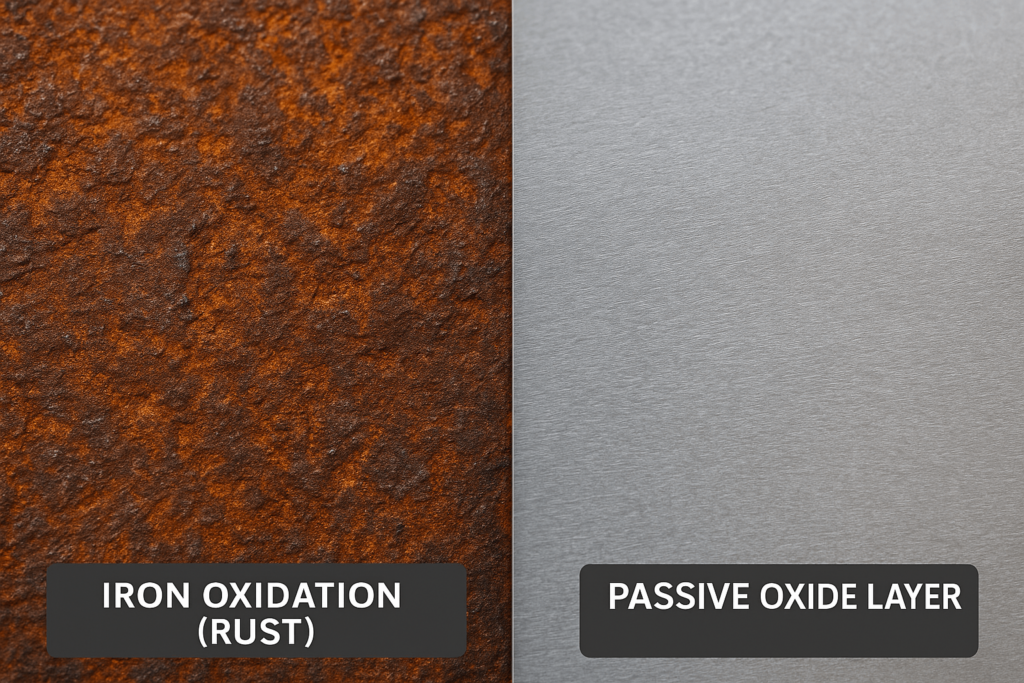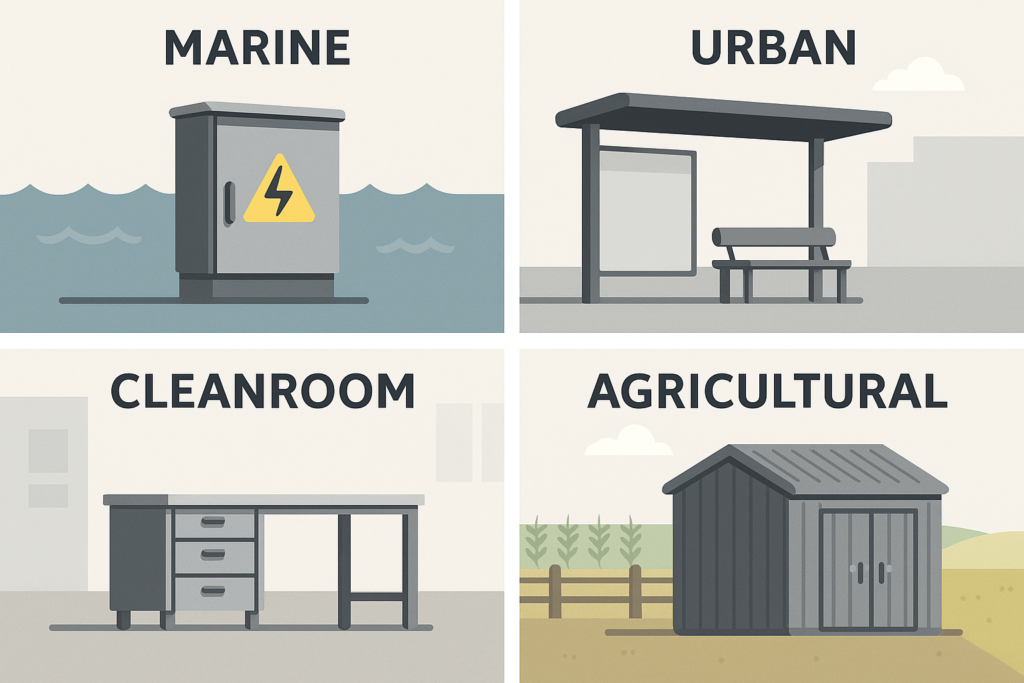Rust is a flaky, reddish corrosion that affects iron and steel. It forms when iron reacts with oxygen and moisture. However, not all metals rust—only those containing iron. Metals like aluminum, stainless steel, copper alloys, and titanium resist rust and offer longer lifespans in industrial applications.
Rust can cause equipment failure, costly repairs, and downtime. For bulk buyers, choosing rust-resistant metals upfront prevents these issues and ensures durability.
In this guide, we’ll explain the difference between rust and corrosion, explore why some metals resist rust better, and help you select the right materials for your projects.

⚙️The Chemistry and Physics Behind “Rust-Free” Metals: More Than Just Material Choice
In large-batch custom manufacturing, “rust-proof” depends not only on the metal itself but also on how it’s processed and finished.
Passive Oxide Layers and Their Role
Materials like stainless steel, titanium, and aluminum naturally resist rust by forming oxide layers that block deeper oxidation. These are self-healing: if scratched, the layer reforms instantly.
For instance, 304 stainless is widely used in indoor commercial cabinetry, while 316 stainless is chosen for outdoor applications due to its higher molybdenum content. Still, even stainless is not infallible—can stainless rust? Yes, under chloride exposure or if improperly finished.
These non corrosive metals perform exceptionally in moisture-prone environments, notably when supplemented with proper design features.
Surface Treatments for Long-Term Protection
Bulk buyers often use coated mild steel instead of more expensive alloys. Powder coating creates a durable polymer layer—but it’s only effective when applied to well-prepared surfaces.
Other finishes include:
Hot-dip galvanizing (zinc layer for sacrificial protection)
Anodizing for aluminum, enhancing corrosion and scratch resistance (though does anodized aluminum rust? Not in typical use cases)
Electrophoresis coating (KTL) for inner cavity protection in industrial enclosures
Table 1: Corrosion Resistance Technologies by Use Case
| Material / Finish | Rust Behavior | Common Applications | Relevant Standard |
|---|---|---|---|
| Stainless Steel (304/316) | Self-healing oxide layer | Cabinets, food equipment, kiosks | ASTM A240, ISO 3506 |
| Galvanized Steel | Sacrificial zinc coating | Shelters, racks, control cabinets | ASTM A653, ISO 1461 |
| Powder-Coated Mild Steel | Polymer layer (barrier) | Low-cost outdoor enclosures | ISO 2360, ASTM D3359 |
| Anodized Aluminum | Enhanced oxide layer | Signage, displays, outdoor frames | ASTM B209, EN 573 |
| Copper / Brass | Forms patina (not rust) | Decorative fixtures, terminals | ASTM B124, EN 1172 |
| Titanium | Strong passive oxide film | Medical, aerospace, corrosive industrial | ASTM B348, ISO 5832 |
Insight: Long-term rust protection requires combining the right material with the correct surface treatment—notably in corrosion resistant sheet metal production for OEM and wholesale projects.
If you’re sourcing low maintenance metals for outdoor infrastructure or rust-resistant coatings for machinery, ensure finish specs match your operating climate.
🌍Matching Metals to Real-World Conditions: What Buyers Need to Consider
Marine and Humid Environments
Coastal or high-humidity zones demand strong corrosion resistance. 316 stainless and anodized aluminum often outperform galvanized steel in these environments.
While stainless steel doesn’t rust easily, welding spots and seams can still corrode. Powder-coated steel will rust over time if not properly sealed—especially at edges or joints.
Tip: Confirm salt spray resistance (ASTM B117 or ISO 9227) when sourcing weatherproof metals for marine enclosures.
Urban and Polluted Settings
Acid rain and urban pollution accelerate breakdown. Galvanized steel can rust if the zinc layer is thin or damaged. Anodized aluminum performs better in UV and chemical exposure.
Example: A city bus shelter using galvanized steel corroded in 2 years; anodized aluminum variants lasted over 7.
For public projects, anodized finishes offer anti-rust solutions for city installations with minimal upkeep.
Cleanrooms and Food Processing
Here, corrosion affects hygiene and compliance. Surgical steel can rust under acidic cleaners. 316L stainless is the go-to for these environments.
Checklist: Use Ra < 0.8µm polish, ASTM A967 passivation, sealed welds.
Also consider food-grade rust-resistant metals that comply with FDA/EU standards.
Agricultural and Outdoor Installations
Aluminum doesn’t rust, but cast aluminum can corrode in fertilizer or wet soil. Galvanized steel is cost-effective, but ensure ≥85μm zinc thickness.
Use Case: For corrosion-resistant materials in farm equipment, match material, finish, and connector type to reduce early degradation.

💰Balancing Performance and Cost in Bulk Projects
Not every application justifies premium metals. For price-sensitive projects, galvanized steel or powder-coated mild steel offer strong performance.
Use matrix logic:
Stainless steel – For hygiene-critical or long-lifecycle parts
Galvanized steel – For low-to-medium exposure
Aluminum – For lightweight and corrosion control
Example: In 10,000 outdoor kiosks, using 316 stainless throughout would triple material cost. A blend of galvanized body + stainless hinges + powder coat cut cost 38% without compromising rust resistance.
In bulk procurement of rust-proof materials for industrial fabrication, think lifecycle fit—not just unit cost.
🚨When Rust-Resistance Isn’t Enough: High-Corrosion Scenarios
In aggressive environments—like offshore rigs, wastewater treatment plants, or chemical facilities—standard rust-resistant metals may fail prematurely. Choosing the right base metal becomes as critical as coatings.
Consider the following materials:
Duplex stainless steel (2205) — exceptional resistance to chloride-induced stress cracking
Nickel alloys (e.g., Inconel) — high-temperature, chemical-resistant
Anodized aluminum (mil-spec) — effective for acidic vapor zones
When coatings are required, opt for:
Multi-layer powder systems compliant with ISO 12944-C5
PTFE coatings for ultra-corrosive or high-friction scenarios
📌 Procurement Tip: In such environments, always request materials tested to ASTM B117, ISO 9227, or similar simulated corrosion benchmarks.
For buyers sourcing corrosion-proof metals for extreme applications, this is where material science meets lifecycle strategy.
❓Most Asked by Bulk Buyers: Rust FAQs
Can stainless rust? — Yes, notably in coastal or chemical-heavy environments. Always passivate and avoid chloride exposure.
Will powder-coated steel rust? — Yes, if edges or scratched areas expose the underlying steel. Proper surface prep per ISO 8501 is critical to maximize coating performance.
Can galvanized steel rust? — Yes. Once the zinc layer is compromised, corrosion begins. Thickness and finish matter.
Why doesn’t stainless steel rust? — Chromium creates a passive layer blocking oxygen and moisture interaction.
Why does stainless steel rust? — Poor finishing, contamination, or neglecting passivation steps are key causes.
📞 Ready to Optimize Material Selection?
YISHANG helps global buyers select and manufacture rust-resistant metal products at scale—from vending machines and smart lockers to energy storage cabinets and custom OEM frameworks.
👉 Ready to request a quote or review your metal design requirements? Contact our team to discuss how we engineer corrosion-resistant results from the ground up.

